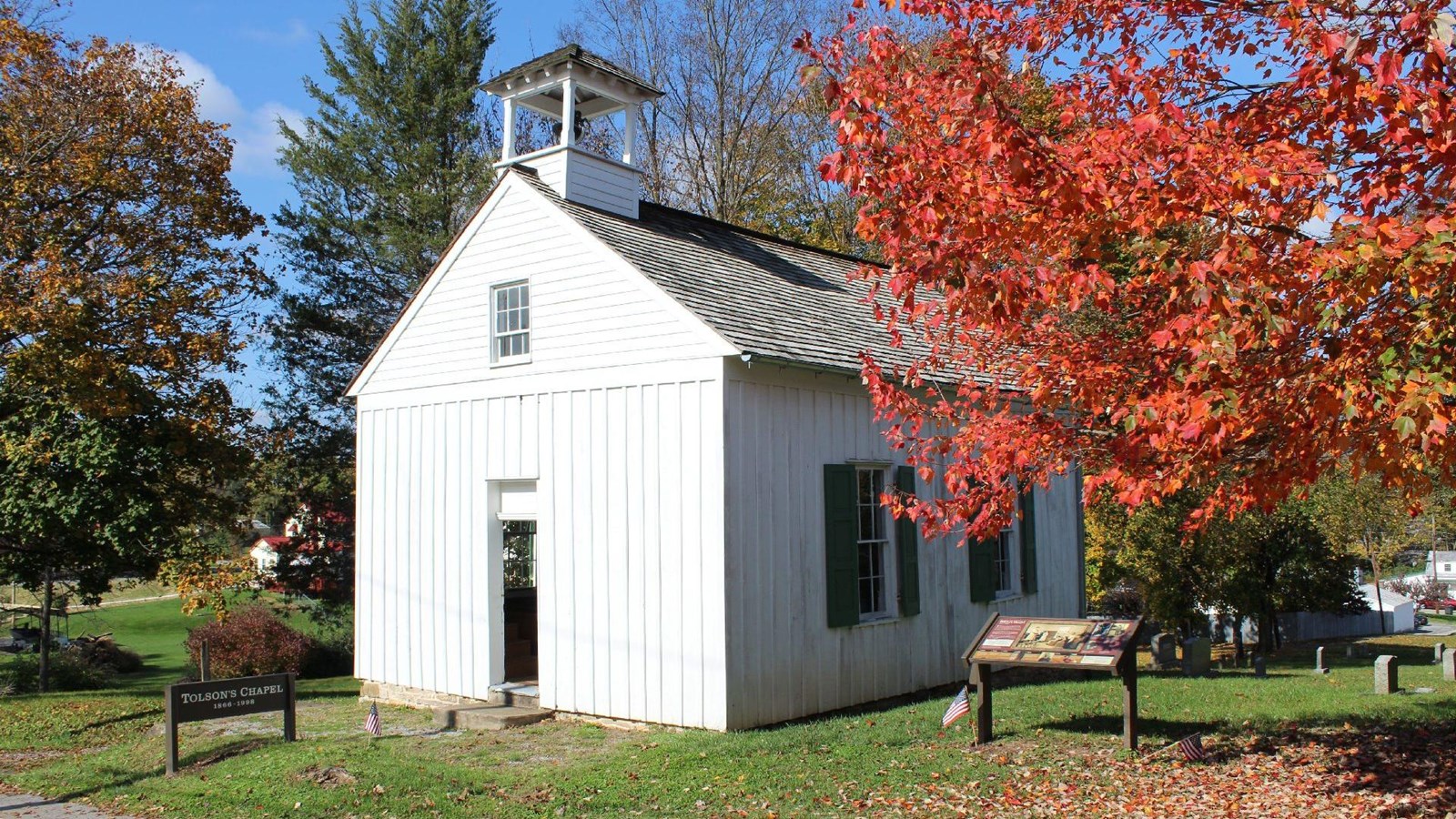Last updated: November 13, 2024
Place
Tolson's Chapel

NPS
Located near Antietam National Battlefield in western Maryland, Tolson’s Chapel is a log-and-frame church built by an African American congregation in 1866. The congregation later established a cemetery on the property, and the church served as a school during Reconstruction. This small church in the town of Sharpsburg powerfully illustrates the importance of churches, schools, and cemeteries to African Americans in the Southern and border states during the transition from a slave society to a free society after the Civil War.
John R. Tolson, a Black Methodist preacher, organized the African American congregation in Sharpsburg in 1865, one year after slavery ended in Maryland. The congregation joined the Washington Conference, an annual conference in the Methodist Episcopal Church (not to be confused with the African Methodist Episcopal (AME) Church). Organized in 1864, the Washington Conference was composed entirely of African American churches. As part of the Washington Conference, members of the African American congregation in Sharpsburg could hold leadership positions within the conference, worship independently from whites, and serve as preachers. Prior to 1864, most Black members of the Methodist Episcopal Church could do none of these things.
The Sharpsburg congregation completed the church building in 1866. By 1875, it was known as “Tolson’s Chapel,” in honor of its founding preacher, who died in 1870. The congregation that gathered in Tolson’s Chapel included men, women, and children who had been enslaved, as well as people who were free before the Civil War. In Sharpsburg and other communities in the former slave-holding states, African Americans who had been free before the war provided crucial support for churches. For instance, African American landowners often provided the land on which to build the church. This was the case in Sharpsburg, where Samuel and Kate/Cassey Craig donated the land for Tolson’s Chapel.
For African Americans who endured and resisted whites’ attempts to control their religious lives during slavery, churches such as Tolson’s Chapel embodied freedom and independence. Preachers and lay leaders were often leaders in the community as well. Though excluded from positions of formal leadership, women in the churches organized fundraisers and other events. Because African Americans owned and controlled their churches, they also used the buildings for activities that whites opposed, such as schools and political meetings.
For one term in 1868 and another term in 1869, the church hosted a school taught by Northern teachers sent by the Freedmen's Bureau Local African Americans and Northern benevolent societies supported the teachers. Starting in the early 1870s, Tolson’s Chapel was the home of the public school for African Americans in Sharpsburg. The public school remained in Tolson’s Chapel until 1899, when it moved to a new schoolhouse down the street.
Like many rural African American churches during Reconstruction, Tolson’s Chapel established a cemetery. In the late 1800s and early 1900s, municipal cemeteries often segregated burials by race or excluded African American burials altogether. Even as some African Americans challenged these policies, they also created their own cemeteries where they – not whites – could control their final resting place. The Tolson’s Chapel congregation purchased the land surrounding the church for $75 in 1883. However, they may have started using this land as a cemetery several years before that. The cemetery contains the graves of Union Army veteran Wilson Middleton, people who witnessed the Battle of Antietam (September 17, 1862), and many who were instrumental in founding and sustaining both the church and the schools in Tolson’s Chapel.
The Tolson’s Chapel congregation remained active through the early 1900s. Starting in the 1950s, the number of members declined as African Americans moved out of Sharpsburg. The church was deconsecrated in 1998, two years after the death of Virginia Cook, the last surviving member. Preservation efforts began in 2000. The non-profit Friends of Tolson’s Chapel currently owns the building, which is open to the public. Tolson’s Chapel was listed in the National Register of Historic Places in 2008 and designated a National Historic Landmark in January of 2021. Tolson's Chapel is owned and managed by Friends of Tolson’s Chapel.
NHL Nomination
National Historic Landmarks (NHLs) are historic places that possess exceptional value in commemorating or illustrating the history of the United States. The National Park Service’s National Historic Landmarks Program oversees the designation of such sites. There are just over 2,500 National Historic Landmarks. All NHLs are also listed in the National Register of Historic Places.
Learn More
Learn more about African Americans and Education During Reconstruction and notable people connected to Tolson's Chapel including David B. Simons, Hilary and Christina Watson, and John J. Carter.
